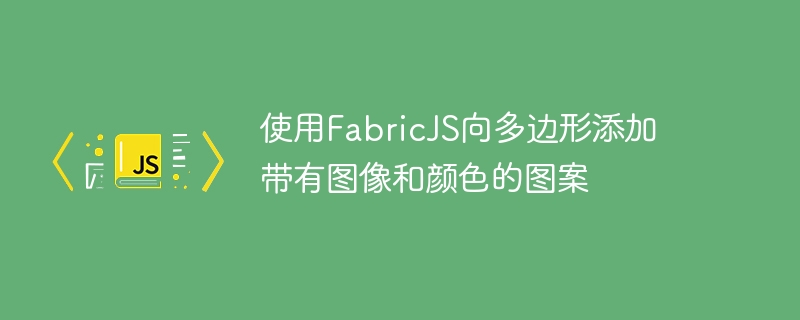使用FabricJS向多邊形添加帶有圖像和顏色的圖案

我們可以透過建立一個 fabric.Polygon 的實例來建立一個多邊形物件。多邊形物件可以由一組相連的直線段組成的任何封閉形狀來描述。由於它是FabricJS的基本元素之一,我們也可以透過套用屬性如角度、不透明度等來輕鬆地自訂它。為了讓多邊形添加圖案和顏色,我們可以使用FabricJS中的Pattern類別。
語法
new fabric.Pattern( options: Object, callback: function )
參數
options (optional) − This parameter is an which provides additional customizations to our object. Using this parameter offsetX, cross-origin and a lot of other properties can be changed related to the Pattern.
callback − 此參數是一個在回呼初始化後呼叫的函數。此參數是可選的。
範例1:建立fabric.Pattern()的實例並將其加入到我們的多邊形物件中
讓我們看一個程式碼範例,看看如何建立一個 fabric.Pattern 的實例並將其新增到畫布中。在這裡,我們建立了一個多邊形對象,它的形狀是一個矩形(一個不規則的多邊形)。我們初始化了 createPattern 函數,該函數將把圖案加到我們的矩形中。最後,我們呼叫了 createPattern 函數,並將所需的 URL 傳遞給它。
<!DOCTYPE html>
<html>
<head>
<!-- Adding the Fabric JS Library-->
<script src="https://cdnjs.cloudflare.com/ajax/libs/fabric.js/510/fabric.min.js"></script>
</head>
<body>
<h2>
Creating an instance of fabric.Pattern() and adding it to our Polygon object
</h2>
<p>You can see that a pattern has been created</p>
<canvas id="canvas"></canvas>
<script>
// Initiate a canvas instance
var canvas = new fabric.Canvas("canvas");
canvas.setWidth(document.body.scrollWidth);
canvas.setHeight(250);
// Initiating the createPattern function which loads image
// and adds the image as pattern to the rect object
function createPattern(url) {
fabric.util.loadImage(url, function (img) {
rect.set(
"fill",
new fabric.Pattern({
source: img,
})
);
canvas.renderAll();
});
}
// Initiating a Polygon object
var rect = new fabric.Polygon(
[
{ x: 0, y: 0 },
{ x: 500, y: 0 },
{ x: 500, y: 200 },
{ x: 0, y: 200 },
],
{
left: 50,
top: 20,
stroke: "black",
}
);
// Adding it to the canvas
canvas.add(rect);
// Calling the createPattern function
createPattern("https://www.tutorialspoint.com/images/logo.png");
</script>
</body>
</html>
範例2:在我們的多邊形中新增圖像和顏色的模式
讓我們來看一個程式碼範例,看看如何為我們的多邊形物件建立一個帶有圖像和顏色的動態模式。在這種情況下,我們使用了fromURL方法來載入圖像,並初始化了一個fabric.StaticCanvas()對象,這是FabricJS的主要渲染表面之一,對於創建動態模式至關重要。
我們使用了 setBackgroundColor 方法來為多邊形設定背景顏色。最後,我們將多邊形物件加入畫布。
<!DOCTYPE html>
<html>
<head>
<!-- Adding the Fabric JS Library-->
<script src="https://cdnjs.cloudflare.com/ajax/libs/fabric.js/510/fabric.min.js"></script>
</head>
<body>
<h2 id="Adding-a-pattern-with-Image-and-Colour-to-our-Polygon">Adding a pattern with Image and Colour to our Polygon</h2>
<p>You can see that a pattern with image and colour has been created and further use the number field to change the pattern density</p>
<label>Add a width value(50-500): </label>
<input type="number" id="changeWidth" value="50"/>
<canvas id="canvas"></canvas>
<script>
// Initiate a canvas instance
var canvas = new fabric.Canvas("canvas");
canvas.setWidth(document.body.scrollWidth);
canvas.setHeight(250);
// Initiating the colour that we want to fill the pattern with
var imgColor = "rgba(216,228,188,0.5)";
// Using fromURL method to load image and add to canvas
// further setting the dimensions and background colour
fabric.Image.fromURL(
"https://www.tutorialspoint.com/images/logo.png",
function (img) {
img.scaleToWidth(100);
img.scaleToHeight(90);
var patternSourceCanvas = new fabric.StaticCanvas();
patternSourceCanvas.add(img);
patternSourceCanvas.renderAll();
patternSourceCanvas.setBackgroundColor(
imgColor,
patternSourceCanvas.renderAll.bind(patternSourceCanvas)
);
// Initiating a Pattern object
var pattern = new fabric.Pattern({
source: patternSourceCanvas.getElement(),
repeat: "repeat",
});
// Adding a polygon object to the canvas
canvas.add(
// Initiate a polygon object
new fabric.Polygon(
[
{ x: -100, y: -175 },
{ x: 100, y: -175 },
{ x: 200, y: 0 },
{ x: 100, y: 175 },
{ x: -100, y: 175 },
{ x: -200, y: 0 },
],
{
top: 30,
left: 10,
strokeWidth: 3,
stroke: "#96c8a2",
fill: pattern,
objectCaching: false,
scaleX: 0.5,
scaleY: 0.5,
}
)
);
// Using getElementById and targeting the input tag with the id as "changeWidth"
document.getElementById("changeWidth").oninput = function () {
img.scaleToWidth(parseInt(this.value, 10));
patternSourceCanvas.setDimensions({
width: img.getScaledWidth(),
height: img.getScaledHeight(),
});
canvas.requestRenderAll();
};
}
);
</script>
</body>
</html>
結論
在本教學中,我們使用了兩個簡單的範例來示範如何使用FabricJS為多邊形新增影像和顏色的模式。
以上是使用FabricJS向多邊形添加帶有圖像和顏色的圖案的詳細內容。更多資訊請關注PHP中文網其他相關文章!

熱AI工具

Undresser.AI Undress
人工智慧驅動的應用程序,用於創建逼真的裸體照片

AI Clothes Remover
用於從照片中去除衣服的線上人工智慧工具。

Undress AI Tool
免費脫衣圖片

Clothoff.io
AI脫衣器

Video Face Swap
使用我們完全免費的人工智慧換臉工具,輕鬆在任何影片中換臉!

熱門文章

熱工具

記事本++7.3.1
好用且免費的程式碼編輯器

SublimeText3漢化版
中文版,非常好用

禪工作室 13.0.1
強大的PHP整合開發環境

Dreamweaver CS6
視覺化網頁開發工具

SublimeText3 Mac版
神級程式碼編輯軟體(SublimeText3)
 JavaScript引擎:比較實施
Apr 13, 2025 am 12:05 AM
JavaScript引擎:比較實施
Apr 13, 2025 am 12:05 AM
不同JavaScript引擎在解析和執行JavaScript代碼時,效果會有所不同,因為每個引擎的實現原理和優化策略各有差異。 1.詞法分析:將源碼轉換為詞法單元。 2.語法分析:生成抽象語法樹。 3.優化和編譯:通過JIT編譯器生成機器碼。 4.執行:運行機器碼。 V8引擎通過即時編譯和隱藏類優化,SpiderMonkey使用類型推斷系統,導致在相同代碼上的性能表現不同。
 Python vs. JavaScript:學習曲線和易用性
Apr 16, 2025 am 12:12 AM
Python vs. JavaScript:學習曲線和易用性
Apr 16, 2025 am 12:12 AM
Python更適合初學者,學習曲線平緩,語法簡潔;JavaScript適合前端開發,學習曲線較陡,語法靈活。 1.Python語法直觀,適用於數據科學和後端開發。 2.JavaScript靈活,廣泛用於前端和服務器端編程。
 從C/C到JavaScript:所有工作方式
Apr 14, 2025 am 12:05 AM
從C/C到JavaScript:所有工作方式
Apr 14, 2025 am 12:05 AM
從C/C 轉向JavaScript需要適應動態類型、垃圾回收和異步編程等特點。 1)C/C 是靜態類型語言,需手動管理內存,而JavaScript是動態類型,垃圾回收自動處理。 2)C/C 需編譯成機器碼,JavaScript則為解釋型語言。 3)JavaScript引入閉包、原型鍊和Promise等概念,增強了靈活性和異步編程能力。
 JavaScript和Web:核心功能和用例
Apr 18, 2025 am 12:19 AM
JavaScript和Web:核心功能和用例
Apr 18, 2025 am 12:19 AM
JavaScript在Web開發中的主要用途包括客戶端交互、表單驗證和異步通信。 1)通過DOM操作實現動態內容更新和用戶交互;2)在用戶提交數據前進行客戶端驗證,提高用戶體驗;3)通過AJAX技術實現與服務器的無刷新通信。
 JavaScript在行動中:現實世界中的示例和項目
Apr 19, 2025 am 12:13 AM
JavaScript在行動中:現實世界中的示例和項目
Apr 19, 2025 am 12:13 AM
JavaScript在現實世界中的應用包括前端和後端開發。 1)通過構建TODO列表應用展示前端應用,涉及DOM操作和事件處理。 2)通過Node.js和Express構建RESTfulAPI展示後端應用。
 了解JavaScript引擎:實施詳細信息
Apr 17, 2025 am 12:05 AM
了解JavaScript引擎:實施詳細信息
Apr 17, 2025 am 12:05 AM
理解JavaScript引擎內部工作原理對開發者重要,因為它能幫助編寫更高效的代碼並理解性能瓶頸和優化策略。 1)引擎的工作流程包括解析、編譯和執行三個階段;2)執行過程中,引擎會進行動態優化,如內聯緩存和隱藏類;3)最佳實踐包括避免全局變量、優化循環、使用const和let,以及避免過度使用閉包。
 Python vs. JavaScript:社區,圖書館和資源
Apr 15, 2025 am 12:16 AM
Python vs. JavaScript:社區,圖書館和資源
Apr 15, 2025 am 12:16 AM
Python和JavaScript在社區、庫和資源方面的對比各有優劣。 1)Python社區友好,適合初學者,但前端開發資源不如JavaScript豐富。 2)Python在數據科學和機器學習庫方面強大,JavaScript則在前端開發庫和框架上更勝一籌。 3)兩者的學習資源都豐富,但Python適合從官方文檔開始,JavaScript則以MDNWebDocs為佳。選擇應基於項目需求和個人興趣。
 Python vs. JavaScript:開發環境和工具
Apr 26, 2025 am 12:09 AM
Python vs. JavaScript:開發環境和工具
Apr 26, 2025 am 12:09 AM
Python和JavaScript在開發環境上的選擇都很重要。 1)Python的開發環境包括PyCharm、JupyterNotebook和Anaconda,適合數據科學和快速原型開發。 2)JavaScript的開發環境包括Node.js、VSCode和Webpack,適用於前端和後端開發。根據項目需求選擇合適的工具可以提高開發效率和項目成功率。






